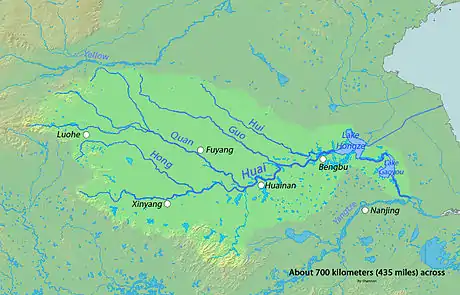Hui River
Hui River (also pronounced as Kuai River), traditionally known as Huan River or Baohui River, was a major tributary of Huai River in northern China. Currently, it flows into the Huai-Hong New Canal[1] , a constructed flood-control waterway connecting Huaiyuan and Hongze Lake. The starting point of Hui River is the ancient Honggou Canal (鸿沟), which has a great historical significance because it was the border between territories controlled by Liu Bang and Xiang Yu during the Chu-Han Contention (206 - 202 BCE).[2] The river is mainly recharged by rainwater and groundwater. The river is heavily polluted by wastewater from nearby towns.
| Hui River Huì River (濊水), Huan River (涣水) Baohui River (包浍河), Kuai River (浍水) | |
|---|---|
 Map showing the Hui River and Huai River | |
| Native name | 浍河 |
| Location | |
| Country | China |
| Region | Northern China and Eastern China |
| Physical characteristics | |
| Source | |
| • location | Xiayi County, Henan province, China |
| Mouth | Huai-Hong New Canal |
• location | Guzhen County, Anhui province, China |
| Length | 131 mi (211 km), Northwest-Southeast |
| Basin size | 1,872.6 sq mi (4,850 km2) |
| Basin features | |
| River system | Huai River watershed and Huai-Hong New Canal |
| Tributaries | |
| • right | Bao River |
References
- "漴潼河水系" (in Chinese). 中国水利网. 2003-02-27. Archived from the original on 2013-04-24. Retrieved 2013-03-28.
- 《中国河湖大典》编纂委员会 (2010). 《中国河湖大典·淮河卷》 (M)
|format=requires|url=(help) (1 ed.). 北京: 中国水利水电出版社. pp. 112~113. ISBN 978-7-5084-7953-8.
This article is issued from Wikipedia. The text is licensed under Creative Commons - Attribution - Sharealike. Additional terms may apply for the media files.